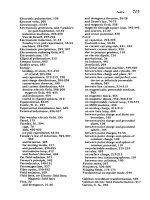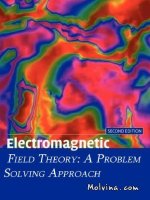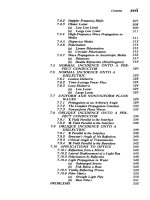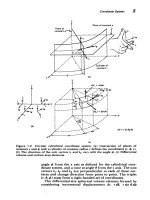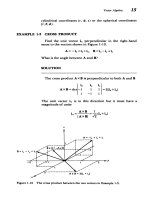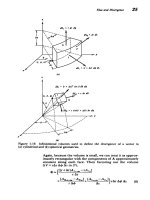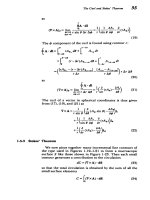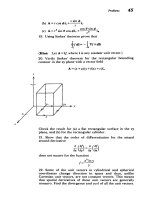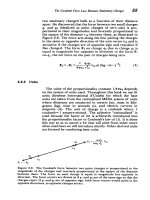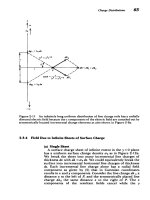Electromagnetic Field Theory: A Problem Solving Approach Part 1 ppsx
Bạn đang xem bản rút gọn của tài liệu. Xem và tải ngay bản đầy đủ của tài liệu tại đây (316.63 KB, 10 trang )
Cartesian
Coordinates
(x,
y, z)
af.
af
af
Vf
=
-
, +
O
i,
+
i,
ax
ay
Oz
aA,
aA,
aA,
V
.
A=
a+
+
ax
ay
az
(LAX,
A
AaA\
.a,
O
aA.
ay
z
az
Ox
ax
ay
V2f
a'
+f
+
a'f
Ox
jy
az
Cylindrical
Coordinates
(r,
4,
z)
Of.
I
af af.
Vf
=
r
4 +• 1
ar
r
04
az
1
a
1iA,
aA,
V
*
A=-
-(rAr)+M
+M
rr
rr a Oz
a
I
BA,
aA.
A,
DA
A.
I(rAs)
A
r
1
xzaz
rr)
'L
ar
a4J
V~
f
a0
l
af\
1 8
2
f a
2
f
r-
+
-2
rr
Ora
r)
14
az
Spherical
Coordinates
(r,
0,
4)
a.
af.
1
af.
Vf=
,+
ae+I
If-14
ar
r
•O
r
sin
0 a
O
A 1
(r
1
a(sin
OAo)
1
oA*
V"
-A=
(rPA,)+
+
r
ar
r
sin
0
ae
r
sin
0
a4
x
1 a(sin
OAs)
aA]
r
sin
a80
04,
a
S
1
MA,
a(rA,))
1
[ra(rAo)
dA,1
r
sio
ar
sin
r
Or
O-
V'f
=
a-"
r-r
r+
a+sin
0
O+
I
a•f
Cartesian
x
y
z
1
,Y
Cartesian
/x
2+y2+z
0
=
cos
/x2'+y2+z'
2
=
cot-
x/y
i,
=
sin
0
cos
,ix
+sin
0
sin
(i,
+
cos
Oi.
is
=
cos
0
cos
oi,
+cos
0
sin
4i,
-sin
Oi.
i,
=
-sin
46i,
+cos
di,
Cylindrical
=
r
cos
c
=
r
sin
q
=
z
=
cos
i,
-
sin
0i
=
sin
0i,
+
cos
0ik
=
i
z
Cartesian
=
tan-
1
y/x
-= z
=
cos
kix,
+sin
i,
=
-sin
0ix
+cos
4iy
= i
Cylindrical
If,-
ý+z
-1 z
=
cos
=
sin
Oi,+cos
Oi,
=
cos
Oi,
-sin
Oi,
=
i
4
,
Geometric
relations
between
coordinates
and
unit
vectors
for
Cartesian,
cylir
drical,
and
spherical
coordinate
systems.
Spherical
=
r
sin
0
cos
4
=
r
sin
0
sin
4
= r
os
0
=
sin
0
cos
i,
+
cos
0
cos
4ie
-sin
Ois
=
sin
0
sin
4i,
+
cos
0
sin
/ie
+
cos
46
i
=
cos
Oi,-
sin
Oie
Spherical
=r
sin
0
Sr
cos
0
=
sin
Oi,
+cos
ie
=
i
4
=
cos
Oi,
-sin
0iO
Cylindrical
Spherical
r
FIELD THEORY:
a problem solving approach
MARKUS
WHN
Massachusetts Institute of
Technology
my
pnrents
V
PREFACE
Electromagnetic
field
theory
is
often
the
least
popular
course
in
the
electrical
engineering
curriculum.
Heavy
reli-
ance on vector
and
integral
calculus can
obscure
physical
phenomena
so
that
the
student
becomes
bogged
down
in
the
mathematics
and
loses
sight
of
the
applications.
This
book
instills
problem
solving
confidence
by
teaching
through
the
use
of
a
large
number
of
worked
examples.
To
keep
the
subject
exciting,
many
of
these
problems
are
based
on
physical
pro-
cesses,
devices,
and
models.
This
text
is
an
introductory
treatment
on
the
junior
level
for
a
two-semester
electrical
engineering
course
starting
from the
Coulomb-Lorentz
force
law
on
a
point
charge.
The
theory
is
extended
by
the
continuous
superposition
of
solutions
from
previously
developed
simpler problems leading
to
the
general
integral
and
differential
field
laws.
Often
the
same
problem
is
solved
by
different
methods
so
that
the
advantages
and
limita-
tions
of
each
approach
becomes clear. Sample
problems
and
their
solutions
are
presented
for
each
new
concept
with
great
emphasis
placed
on
classical
models
of
such
physical
phenomena
as
polarization,
conduction,
and
magnetization.
A
large
variety
of
related problems
that
reinforce
the
text
material are
included
at
the
end
of each
chapter
for
exercise
and
homework.
It
is
expected
that
students
have
had
elementary
courses
in
calculus
that
allow
them
to
easily
differentiate
and
integrate
simple
functions.
The
text
tries
to
keep
the
mathematical
development
rigorous
but
simple
by
typically
describing
systems
with
linear, constant
coefficient
differential
and
difference
equations.
The
text
is
essentially
subdivided
into
three
main
subject
areas:
(1)
charges
as
the
source
of
the
electric
field
coupled
to
polarizable
and
conducting
media
with
negligible
magnetic
field;
(2)
currents
as
the source
of
the magnetic
field
coupled
to
magnetizable
media
with
electromagnetic
induction
generat-
ing
an electric
field;
and
(3)
electrodynamics
where the
electric
and
magnetic
fields
are
of
equal
importance resulting
in
radi-
ating
waves.
Wherever
possible,
electrodynamic
solutions
are
examined
in
various
limits
to
illustrate
the
appropriateness
of
the
previously
developed
quasi-static
circuit
theory approxi-
mations.
Many
of
my
students
and
graduate
teaching
assistants
have
helped
in
checking
the
text
and
exercise
solutions
and
have
assisted
in
preparing
some
of
the
field
plots.
Markus
Zahn
I
